#morphologies
Explore tagged Tumblr posts
Text
5 Morphologies en dessin
N’en avez-vous pas marre de voir et/ou dessiner tout le temps les mêmes silhouettes ? Et si on apportait un peu de diversité à tout ça ? Dessiner le corps humain a toujours été d’actualité à travers l’histoire. Que cela soit à l’époque de la Préhistoire et jusqu’à maintenant, la forme humaine est une continuelle source d’inspiration pour les artistes. Cependant, comprendre la diversité des corps…

View On WordPress
#morphologie pomme#morphologie sablier#morphologie triangle#morphologie triangle inversé#morphologies
0 notes
Text
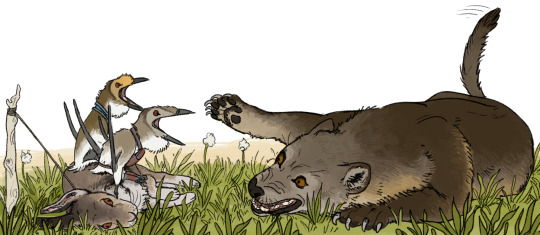
Two People Of the Midnight Sun guarding a snared hare against a juvenile sunsinger, a wolf sized mustelid that lives as an ambush predator and opportunistic scavenger in the arctic tundra and gets its name from the male's yowling calls during the springtime breeding season.
These people primarily manufacture small knives for skinning prey and bloodletting their host animals, and do not have weapons capable of dealing with large predators. Their primary defense in this situation is the tried and true predator mitigation strategy of puffing up and making a lot of noise. Like their caelin/delkhin relatives, polar caelin have gular sacs that amplify their calls, primarily used for long distance communication and song but also adequate for making a general cacophony.
This sunsinger physically outmatches its foes by a long shot, but is hesitant to get any closer to a pair of loud, unfamiliar, and seemingly fearless opponents, and quite frustrated about this whole situation. It will most likely walk away from this confrontation hungry rather than risk a physical altercation, particularly when reinforcements from these people’s clan hear all the yelling and come to dive bomb the shit out of it.
#Polar caelin are an entirely different species to the rest. In spite of their radically different morphology wrt wings caelin are a little#more closely related to delkhin than to these guys.#Caelin and polar caelin are not mechanically capable of breeding/laying each other's eggs and even if they were they would#only produce sterile young (while caelin and delkhin can produce fertile male hybrids and sterile females)#The range of polar caelin peoples is confined to the northern polar landmass and some of its islands because they aren't proficient#at gliding flight and can't disperse overseas. Whereas mainland caelin have populations everywhere including the arctic#The sunsinger is based off Ekorus#creatures#people of the midnight sun
836 notes
·
View notes
Text
youtube
please i need you to watch this deadpan german linguistics professor making an incredibly catchy nerd pop song and dancing it's been stuck in my head all day
#linguistics#linguist humour#i put the antics back in semantics#you'll scream for more more more morphology#christian uffmann#linguistics professors say the darnedest things#songs#pop songs#nerd pop#Youtube
744 notes
·
View notes
Note


What color morphs are these guys? Are they standard crosses (the closest I can find) with the black just being more prominent and a brighter orange, or a different kind? Apologies if you already have these kinds somewhere on your account I don't believe I've seen them xd
Yes, these are Standard Cross foxes! The brighter orange is very likely due to editing. Cross foxes can have bright orange markings, but that extremely bright color would likely never occur, unfortunately. Cross foxes with more silver fur present are also called Silver Crosses (Pictured below) but I don't believe either of the foxes you showed would qualify.

TLDR: they're Standard Cross foxes like the one below, but they were edited to look more vibrant.

Thanks for the question! Don’t be afraid to ask anything, I really don’t mind repeat questions :)
#species: red fox#foxes#fox#red fox#fox color morph#fox colour morphs#morphology#biology#asks#color: cross#color: silver Cross
438 notes
·
View notes
Text
Fuck it. *lexicalizes your compounds*
578 notes
·
View notes
Note
it's fascinating to me how endlessly complicated High Valyrian seems to be when you answer questions about it. Is there any language in the world more or less at the same level of complexity?
It depends how you're thinking of complexity. All the languages of the world are equally complex. They have to be, because they all need to perform the same function, and they're all used by the same human brains living inside the same humans living human lives. I think English speakers (and hypothesize that, by extension, the same would be true of Chinese speakers, Hawaiian speakers, Vietnamese speakers, Swedish speakers) look at certain other languages and think of them as more complex in the meta sense because they are more morphologically complex.
By this, I mean in English, for a noun you need to know its singular and plural form—that's it. For a verb, you need to know its -s form, its -ed form, its -ing form, and, very rarely, its -en form. There is some irregularity in form for almost all of these (-ing appears to always be regular), but there aren't more forms, outside of "to be", which has a unique first person singular form.
And...that's it, really. We have adjectival comparison, I guess, but even that can be traded out for an expression (aside from "better" which can't be replaced easily by "more good", most comparatives can be replaced—e.g. you can say something is "more red" than something else even though you can also say it's "redder" than something else). There aren't many word form changes in English a user has to learn in order to be able to use those words in a sentence. The same is true of those languages I listed in the parenthetical phrase above.
Compare that to Spanish, where there are more word form changes for verbs in the present tense (indicative and subjunctive) than in the entirety of English. And that's just one tense for verbs! There's loads more that needs to be memorized; many more word form changes you need to know to be able to use words effectively in a sentence. And there are irregularities on top of that!
Is it the case, therefore, that Spanish is more complex than English?
Certainly, Spanish is more morphologically complex, but does that mean you can express more in Spanish than you can in English? Certainly not! So then what does it mean when we say Spanish is more morphologically complex than English? What's the upshot? What does it mean for the language user?
Perhaps it would help if we compare some Spanish verbs and their English translations:
hablabas "you were talking"
hablé "I spoke"
hable "you would speak"
The precise translation of these verbs will depend on context, but this is a fine example. These are all single words of Spanish. They're different forms that must be memorized, but they're single words. The English requires at least two words for each concept.
So which is more complex? On the one hand, you have fewer words but more forms. On the other, more words, and more words = bigger.
And that, essentially, is the crux of it.
Any time you have complexity baked into single words morphologically in one language, you'll find complexity in the form of multiword expressions in a less morphologically complex language. The meanings are always there(*), but they're expressed in different ways.
As English speakers, we're used to having to express things in multiword expressions, and a speaker of a given language will find their own language to be simple just because. We extend that to think of languages like ours as simpler than those that are different. But, in truth, it's six of one, half dozen of another. Furthermore, there's just as much complexity in languages with less morphological complexity. Consider the following expressions in American English:
I walked to the store. ✅
I walked to a store. ✅
I walked to store. ❌
That's pretty standard. English has articles and you need to use them, right?
I ate the dinner. ✅
I ate a dinner. ✅
I ate dinner. ✅
All those are okay. They don't mean the same thing—and, indeed, the first two have much more restricted contexts—but they're all okay. That's a little weird, isn't it?
Not as weird as this:
I made it by the hand. ❌
I made it by a hand. ❌
I made it by hand. ✅
The first two aren't just weird: they're yikes-a-doodle-do wrong. You might try to brush it aside and say that it's just an expression, and, sure, it is, but ask yourself this: how'd that expression come about in the first place? This one is actually from Shakespeare (Romeo and Juliet) and still works the same way in American English:
You kiss by the book. ✅
You kiss by a book. ❌
You kiss by book. ❌
And just for funsies:
He won by the nose. ❌
He won by a nose. ✅
He won by nose. ❌
You might think the way these shake has to do with what they stand for—that the semantics of the noun in question condition whether or not you can use articles—but consider the first one "store" and compare it to this one:
I walked to the Barnes & Noble. ✅
I walked to a Barnes & Noble. ✅
I walked to Barnes & Noble. ✅
Barnes & Noble is a store, but refer to it by title, and suddenly it's all okay.
Now, if your native language is English, ask yourself: when and how did you learn all of this? Did someone sit you down and tell you where to use which articles and where not to? I'm sure there was some level of instruction you got in elementary school (whether it was accurate or not), but how much of a difference do you think that made? Did you just not use articles before then? And even now, could you explain this? Do you even think about it? Or do you just do it—flawlelssly and effortlessly? Adult learners of English will tell you learning this stuff is a nightmare. Throw in phrasal verbs (pick up vs. pick out vs. pick on vs. pick up on vs. plain old pick) and suddenly English doesn't look too simple anymore.
Bringing this back to your question, when you look at High Valyrian, is there a natural language with an equal amount of morphological complexity? Sure. Maybe something like Latin. But understand that any language will be as complex—not more, not less: as. The only difference with High Valyrian, actually, is its vocabulary isn't as large (give me a couple decades), and it doesn't have nearly as many users as any natural languages. It's also being kept artificially small, in that the language is built up to fit a fictional reality, rather than being expanded to handle anything, the way modern languages are. But pick up any language and it will be equally complex.
(*) From above, it is not always the case that the same "meanings" will be in the equivalent translation of a given sentence. A good example is gender. If you say El río es largo in Spanish it means "The river is long" in English. Like, exactly that. There is no question that these two phrases are functionally equivalent. HOWEVER there is more information in the Spanish sentence. The words el, río and largo are all masculine gender. What does that mean? Nothing more than that they're not feminine. If you hear el in Spanish there are a limited number of words that can legally follow it. When you hear largo, you know that what it refers to has to be in the same class. The function of this is simply to enrich the signal. If you only hear "is large" in English from the previous sentence, you have no idea what noun is large. If you hear es largo in Spanish, you also don't know—but whatever that thing is, you know it has to be masculine. That means that if a Spanish speaker has to guess what es largo they were trivially have a better shot at guessing correctly than an English speaker guessing what "is large" (e.g. if an English speaker has a one in a million shot, a Spanish speaker has a one in 500,000 shot, because roughly half the nouns of Spanish are masculine and half feminine). This means, technically, there's more information in the Spanish sentence than the English sentence, and that information is not represented at all in the English sentence, and is, essentially, unrecoverable. But that "information" is more morphological in nature than semantic.
332 notes
·
View notes
Text
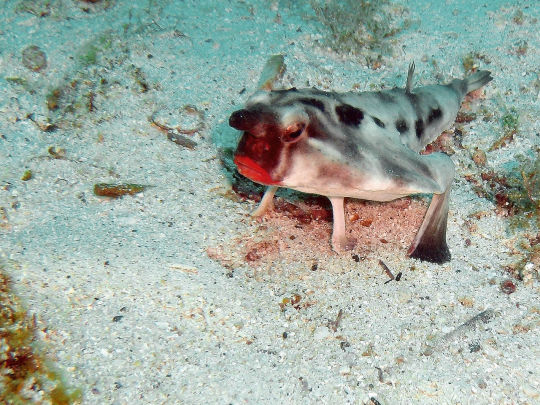
By Rein Ketelaars - Flickr: DSCN1938.jpg, CC BY-SA 2.0
#red-lipped batfish#galápagos batfish#batfish#fish#you know you've got something good when even wikipedia's neutral language describes it as having “unusual morphology”#wet [critter creature or beast] wednesday
377 notes
·
View notes
Text

Two blokes slacking off at work :p
Cretan diplomats based on a painting of the tomb of Rekhmire, Luxor. I was intruigued by the leopard skirt thingy one of them is wearing and drew a more or less realistic interpretation of it! The other guy's there so he can have a buddy.
While i usually draw people looking as average as possible, it's not the case here. It's fair to assume that within the "PR" context of the painting (representing their people in front of a foreign king) these would be the ancient aegean's hottest boytoys, so I kept them snatched and smooth shaved.
Originals under the cut!
Mural with my chosen duo highlighted

Cropped closeup, leopard skirt guy on the left (and the two arms of jugs guy!)
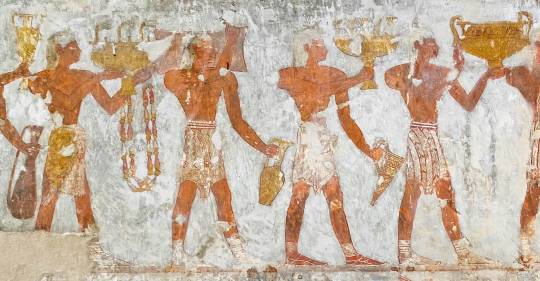
#.csp#2024#minoan#egyptian#historical#bronze age#i genuinely wonder if ppl shaved/waxed back then. i dont remember seeing any depictions of minoan men with facial hair#of course genetics change with populations across the ages etc but modern ppl from the same zones tend to be rly hairy so whats up with tha#additional design notes: gave them slight variations in build and skin color just because. its not on the originals#ancient egyptians DID paint diff morphologies but its all extremely stylized so assuming the ppl on that mural were modeled off real ppl#theyd not have been fat. but the exact details r muddy and open to interpretation#speaking of interpretation im just a nerd i have no formal education in all this dont get my ass for innaccuracy
173 notes
·
View notes
Text
Happy for all the 13-year-olds who may or may not know that they're queer yet who are going to get into Uglies because of the movie. Was skeptical but Shay's haircut gives me hope.
#original#uglies#reject the vision of your future that is preoffered#do not let them mold you into what is desireable#run off into the woods with a weird punk girl#do lots and lots of crime#punch an evolutionary psychologist in the face#overthrow the government and create a new society in which everyone has full morphological freedom
154 notes
·
View notes
Text

quick bitchy girlfriends jamex from this gifset
#because i have an exam tomorrow and im procrastinating revising (shivers) morphology...#love them#sorry if jamie doesnt look like jamie im not used to drawing him 🙏🙏😓#arctic monkeys#jamex#jamie cook#alex turner#art tag
72 notes
·
View notes
Note
Do you have any tips for telling people my favorite amphibians are caecilians, without thinking I mean Sicilians?
Play them this: https://youtu.be/xxsUQtfQ5Ew?si=ZZLUOAYIxzb3EfVk
youtube
#I play this for my Animal Morphology class#among other things#always gets a smile or two#caecilians#answers by Mark#spontaneousmusicalnumber#highly relevant username
219 notes
·
View notes
Text
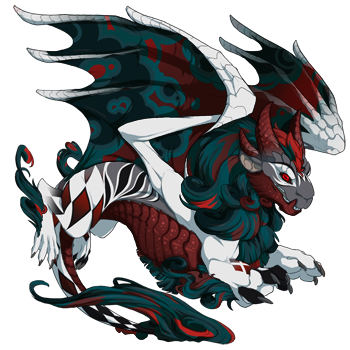
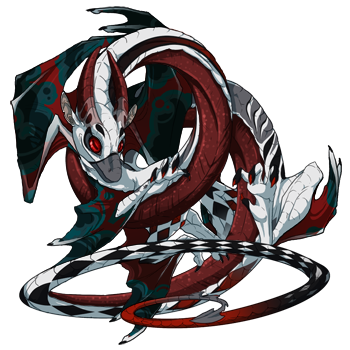
flint harlequin / blood malachite / blood glimmer / goat plague
#flight rising#fr#flight rising scry#flight rising scrying#flight rising scrying workshop#fr scry#fr scrying#flight rising morphology#fr morphology#flight rising obelisk#flight rising spiral#obelisk#spiral#red#blue#white#black
261 notes
·
View notes
Note
heyyo, sorry if it's a bother but I remember you mentioning somewhere (in the tags of something?) that hungarian might even have more than 18 cases if we count it a different way and I lost that post but I'm still very curious, could you tell me more about this or point me to a source? I love terrorising international friends with the hungarian case system
It's NEVER a bother to talk about linguistics :DD This is gonna be a bit long tho.
The reason for this is that Hungarian has like a million suffixes and not all of them are created equal. So there is a bit of debate over what, exactly, constitues as a "case" here.
The currently accepted safe list of the 18 Hungarian suffixes that are definitely totally cases looks like this:

This is already hilarious, because you, as a native speaker, have no idea what these terms mean, and also because there is nothing at essive-modal in this example. Because we just do not decline the word jég in that case.
(Essive-modal is the -ul in "jutalmul" and "[beszélek] magyarul" btw. Is 'jegekül' a word that exists and makes sense? Discuss.)
These are the "bare minimum" of cases that fit both of the two (currently accepted) rules that 1) a case can be a compulsory argument of a verb (aka you can have a verb that you have to use a specific case with, like "beléptem a házba") and 2) only cases can follow other suffixes (I actually can't think of an example for this rn lol).
Thinking about it, you might even get by with saying we have 17 cases in a pinch, since essive-modal is such a weirdo and useless for like most nouns. Don't quote me on this one though.
Anyways, if you're a bit more daring, you can look at all the other suffixes and say "well, why can't these be cases too?" Like come on, this is missing genitive. Why is it missing genitive? So you put in genitive (embernek). And if that's in, then why can't the others be there too? Which is how you end up with off-the-wall cases like temporal (ötkor), sociative (kutyástul), locative (Győrött), distributive-temporal (hetente), and so on until you reach like 34, or however many suffixes there are. Every suffix can be given a fancy overly specific case name to horrify poor non-Hungarian speakers.
Wait, did I say the bare minimum was 18(-17) cases? Actually no, the bare minimum is ZERO cases. Because you can take the enlightened opinion that "case" as a concept should not be applied to agglutinative languages like Hungarian, and Hungarian cases are actually better understood as postpositions affixed to a noun. (Funnily, this is actually how some of those suffixes became suffixes. Ex: hodu utu rea -> hadi útra.)
So, there you have it. The number of cases in Hungarian is a number between 0 and 35. But probably 18. Unless it's not.
#fun game: take a word. put the randomest suffixes on it to create a word that has probably never been used in all of history#we played this in morphology class every so often#“elvíztározlak” was where i actually thought i'd start crying from laughter#my favorite threat. vigyázz mert elvíztározlak.#🌌#i wanted to find a pic of a list of all the really wild “cases” like distributive-temporal but i couldn't :(#maybe i'll make one idk
63 notes
·
View notes
Text
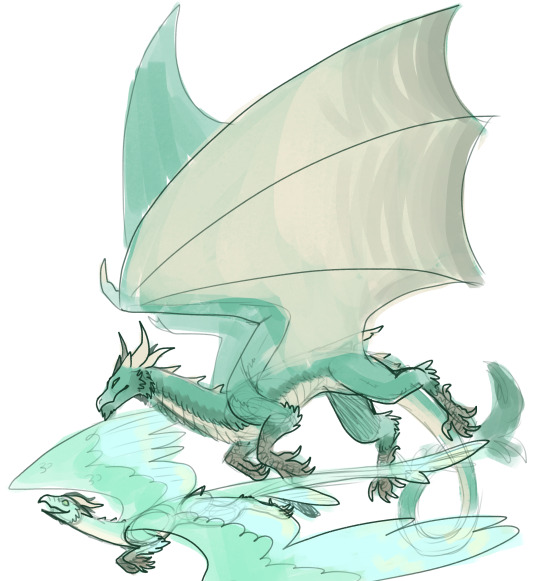
i haven't posted anything in a while, so here, hold this. one of my commissioners wants me to draw dragon seteth + flayn, so here's my first stab at their designs.
#my art#fe3h#fire emblem three houses#fe16#fire emblem#seteth#flayn#dragons#i fumbled around with seteth's design a lot and i might still make changes. we'll see#i'm pretty fucking happy with flayn's design tho i knew exactly what i wanted to do with her#in the actual commission i'll probably make it more apparent that her flight feathers are shimmery#real talk i tend to lean VERY heavily on macuil's design when i think abt 3H dragon designs#i always look at rhea first for general shapes#and then i tend to look at macuil for details#i tried to shake up seteth's facial structure a little so i wouldn't be giving EVERYONE bird-face#bc byleth has bird face and flayn has bird face [because of macuil having bird face and me liking it]#it's really insane to me how much morphological variety there is in RELATED members of the same species...????#rhea is a lizard and macuil is a bird and indech is a TURTLE?#rip to indech i never reference him. sorry
158 notes
·
View notes
Text

Im back with more biodiversity rambling!!!
Went for a simpler style to doodle these guys out a little faster bc i have MANY thoughts always (warning this may or may not be coherent, i apologize in advance)
IMPOARTANT NOTE: the only thing even remotely canon here is the Forest and Reef Na'vi (debatable bc they are still my own interpretations), everything else is just my own musings and personal need for more variation among Na'vi.
In previous posts i think i mentioned the insane venn diagram that lives in my head of forever overlapping and endless combos of Na'vi yadayadayada, this is (LOOSLY) that.
SO, if you have seen my initial post (here) some of these guys might be familiar, but since then, i added Wetlands, Highlands, Glacier and Ash? people! And I have Thoughts ™️
Now I'm gonna hold off on Ash? people for the most part here, mostly because i am a creature that likes at least some level of "Canon Compliance" and we really won't know anything about them until the next film, so i have yet to form any solid headcanons. That being said, I do have a couple quick things:
The name 'Ash People' leads me to think that their generally building lives/evolving around volcanic areas, grey/darker skin tones from evolving around ash?
Thicker/rough skin (volcanic rocks are sharp!) and less fur/fluff on their tails.
Wetlands I imagine as clans that have evolved as a combo or River and Reef, but also Plains, as wetlands (at least as I understand them, i know that there's more to them than this but I am simplifying here) are effectively big wet fields.
I liked the idea of how if River Na'vi developed 'armor' due to swimming in constantly moving water with lots of rocks/fish/debree/etc, that Wetlands might be similar, but not quite on the same level.
Comparatively, Wetlands have no claws, and a thinner more paddle-like tail, more similar to Reef Na'vi.
Highlands I see as Plains Na'vi that evolved for colder biomes, so they keep the builds, maybe in general larger on average, closer coloring to Plains Na'vi and the longer tails, fur and claws of Mountain Na'vi.
Lastly Glacier Na'vi is the Mountain + Reef combo to create the giant spotted seal people of my dreams. I did not show it well here, but I think both Mountain and Glacier hold more fat in their bodies than other Na'vi, as well as Reef Na'vi being physically larger as well. That combo probably makes Glacier Na'vi massive (like 12-14 ft tall). Living in significantly colder climates, they need to be able to hold more heat in their bodies too, so they are physically much larger all around.
All of these are still just loose and I continue to be vague about a lot of it bc biodiversity and cultures that evolved around a given biome are two separate things to me. I like that these can be used as like umbrellas that the actual clan cultures can be born under, but not 'rules' or anything.
(I do have at least 1 (possibly 2) fan clan situations cooking in my noggin that i am slowly working on, but that's also something i want to be very conscientious about as I build it out.)
Anyways! Thanks for reading if you made it this far! Let me know your thoughts, I love talking about this sort of thing, hearing people's feedback and building off of it!!
#atwow#avatar the way of water#avatar way of water#atwow fanart#james cameron avatar#froglet rambles#navi biodiversity#navi morphology#navi avatar#froglet doodles#avatar frontiers of pandora#afop
113 notes
·
View notes
Note
This story is so cool! Love seeing clangen be used to make xenofic stories centered around species other than domestic cats, it's really inspiring. Especially loving the use of sabertooth felids (currently reading sabertooth by Mauricio Antón!)
YESSSSS SABERTOOTH BY MAURICIO ANTÓN!!
I have the full pdf and it's such a fun read, I love his art (even if some of the animal depictions are a bit outdated now- cover those teeth!)

And thank you! I had been really creative blocked over the last few years, so made Moon 0 with no real plan or expectations except "workdbuilding from earlier project but RNG with clangen for less stress" XD
I really enjoy reading xenofiction, so non-warriors clangens are exciting to me :D
(Anyone can feel free to plug a fav in the comments if you have recommendations btw!
#mammothask#anon#ooc ask#pav chatter#i also want to be clear that im not shading Mauricio by calling Sabertooth outdated#he has himself said that bc he's one of the biggest advocates for sheathing the sabers on all sabercat bar Smilodon#bc smilodon has a specific morphology in its lower jaw allowing for the lips to seal around the exposed sabers#Homotherium and other scimitars dont have that- so they realistically Have to be sheathed#also i just like how it looks ngl- concealed weaponry!#homotherium#clangen#sabertooth#smilodon#sabercat#sabertooth tiger
59 notes
·
View notes